I use this code for smoothing data by fitting exponent with scipy.optimize.curve_fit:
def smooth_data_v1(x_arr,y_arr):
def func(x, a, b, c):
return a*np.exp(-b*x)+c
#Scale data
y = y_orig / 10000.0
x = 500.0 * x_orig
popt, pcov = curve_fit(func, x, y, p0=(1, 0.01, 1))
y_smooth = func(x, *popt) # Calcaulate smoothed values for same points
#Undo scaling
y_final = y_smooth * 10000.0
return y_final
Howewer I want estimated exponent curve to go through 1st point.
Bad case:
Good case:
I have tried to remove last parameter using first point x0,y0:
def smooth_data_v2(x_orig,y_orig):
x0 = x_orig[0]
y0 = y_orig[0]
def func(x, a, b):
return a*np.exp(-b*x)+y0-a*np.exp(-b*x0)
#Scale data
y = y_orig / 10000.0
x = 500.0 * x_orig
popt, pcov = curve_fit(func, x, y, p0=(1, 0.01))
y_smooth = func(x, *popt) # Calcaulate smoothed values for same points
#Undo scaling
y_final = y_smooth * 10000.0
return y_final
Howewer something go wrong and I get:
a param is really large
popt [ 4.45028144e+05 2.74698863e+01]
Any ideas?
Update:
Example of data
x_orig [ 0. 1. 2. 3. 4. 5. 6. 7. 8. 9. 10. 11. 12. 13. 14.]
y_orig [ 445057. 447635. 450213. 425089. 391746. 350725. 285433. 269027.
243835. 230587. 216757. 202927. 189097. 175267. 161437.]


